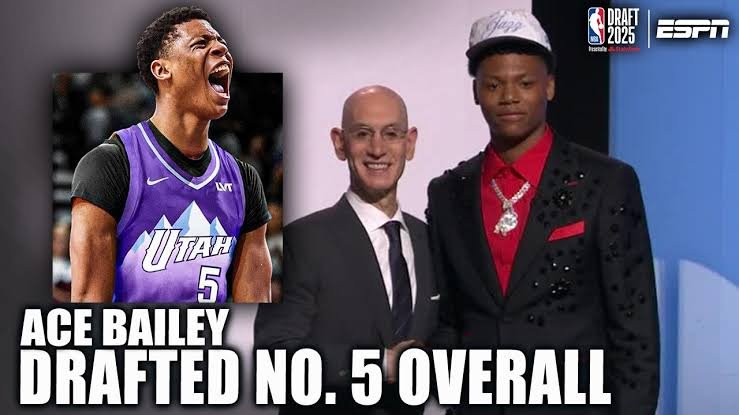“Jazz Shock and Awe: Ace Bailey’s Unlikely Landing in Utah”
The NBA world was rocked on draft night when the Utah Jazz seized Ace Bailey, the consensus five-star Rutgers wing, with the 5th overall pick in the 2025 NBA Draft. What made this pick seismic wasn’t simply his talent—but the fact that Bailey seemingly didn’t want to land in Salt Lake City. His camp reportedly told multiple top-five teams, “Don’t pick me,” and he skipped workouts with several organizations, including Utah, raising eyebrows and shifting perceptions So when his name was called, reactions ranged from sheer shock to cautious praise—both within the fanbase and across the league.
The Pre-Draft Puzzle: Bailey’s Quiet Power Play
Barry entered the draft as a top-three talent, expected to be selected early in the night. But his pre-draft process diverged sharply: no private workouts, public whispers about preferred destinations (Washington, New Orleans, Brooklyn), and agents reportedly urging teams to pass on him It was a bold strategy—a high-wire act reminiscent of Shedeur Sanders’ NFL gambit—which ultimately appeared to cost him roughly $9 million, sliding from a projected top-three to 5th
This risky move carried substantial upside: if teams valued his game enough, he could still go early—and reportedly still did. But it also brought scrutiny: was he immature, entitled, or simply savvy about controlling his destiny? One cryptic quote from Jonathan Givony sticks:
“Utah was not one of his preferred destinations… a stunner”
Studio pundits debated whether he had overplayed his hand—but the Jazz evidently believed the gamble was worth it.
Scouting Ace: Talent That Shines Through the Noise
Despite off-court theatrics, Bailey’s on-court skills were impossible to ignore. At Rutgers, the 6′8″ forward averaged a standout 17.6 points, 7.2 rebounds, 1.3 blocks, and 1.3 steals, showcasing a deadly shot-making ability, athleticism, and defensive potential (
- Versatile Scorer: Elite three-level threat—from catch-and-shoot to contested mid-range fadeaways and fast-break pull-ups
- Physical Tools: 7-foot wingspan, explosive first-step, shot-blocking instincts—combining the length of Andrew Wiggins with the craft of Rashard Lewis (slcdunk.com).
- Defensive Upside: Weak-side protection and versatile mobility on the wing .
That potent blend justified a bold move, even if, on paper, Utah seemed off-script.
Draft Night Drama: Shockwaves and Ownership Support
When Bailey heard his name at No. 5, his reaction was subdued—almost stunned, triggering viral moments and fan speculation that he really hadn’t expected Utah to pull the trigger (si.com, profootballnetwork.com):
“Ace Bailey looks like he’s about to cry pic.twitter.com/…” (profootballnetwork.com).
Fans on social media oscillated between alarm and excitement. Some feared he’d struggle to commit, saying “He is gonna want out.” Others saw upside in the risk, praising the Jazz’s “homerun swing” (profootballnetwork.com).
Behind the scenes, Utah’s front office—helmed by Austin and Danny Ainge—stood tall, confident in their vision (bundle.app). Even minority owner Dwyane Wade jumped in, tweeting:
“When you can get a player as talented as ACE with the 5th pick you don’t overthink it, you do it! Good job @utahjazz” (profootballnetwork.com).
This public support added a layer of legitimacy to what looked like a gamble.
Integration in Utah: Pathways and Pressures
Now in Salt Lake City, Bailey joins a rebuilding Jazz team (17–65 last season). He arrives alongside Walter Clayton Jr., a polished guard from Florida they acquired later in the first round—another key drafting decision (slcdunk.com).
From Utah’s perspective:
- Immediate Opportunity: As a long, athletic scoring wing, Bailey plugs into a roster that desperately needs offense.
- Long-Term Potential: With proper development, he could evolve into an All-Star-caliber piece.
- Cultural Fit: Despite pre-draft whispers, Utah insists Bailey was personally impressive in combine interviews and film sessions—“fun… smiles every day” (ksl.com, profootballnetwork.com).
The criticism—that his off-court stance was immature—seems forecasted. Utah’s stance, as echoed by Windhorst: “They will absolutely not budge … Ace … is going to be a Utah Jazz” (bundle.app). Over the next year, focus will fall on his adaptation: will he anchor a budding rebuild or prove to be a restless star?
The Verdict: Calculated Risk, Big Upside
In sum, Utah’s selection of Ace Bailey at No. 5 represents a high-risk, high-reward maneuver. They bypassed safer, more predictable players—those having polished workouts and clear preferences—in favor of elite ceiling and tools-first upside.
- Risk: Will Bailey buy in after forcing his slide?
- Reward: A potential franchise cornerstone with size, scoring, and athleticism.
- Support: From ownership (Wade), front office (Ainge), and coaching (Will Hardy).
Final Word
The NBA thrives on narrative tension—and this draft night delivered one of the most electric stories of 2025. Ace Bailey’s fall, framed by his own strategic ploy, has landed him in Utah through a Jazz team unafraid to defy convention. Now, the task falls to him—and to Utah’s development machine—to make this bold pick pay dividends. Will he become the next breakout wing? Or will the mismatch in expectations doom the partnership?
Either way, this is a storyline worth following closely—and if it works, Jazz fans might soon be cheering the courage of that crazy No. 5 pick.
